
 |
Unlimited Air Racing at Reno 2012
Text and Photos by Dan Whitney
After The Galloping Ghost’s tragic accident at Reno 2011 the future of the races was an unknown. It was not certain that there would ever again be Unlimited air racing. Immediately following the accident the NTSB established a comprehensive accident investigation leading to hearings where all interested parties participated, including the Reno Air Race Association (RARA), the event manager, the National Air Racing Group’s (NAG) Unlimited Division and many others. Separately, RARA established a Blue Ribbon Review Panel of highly experienced race pilots, race officials and crew chiefs to review and investigate every aspect of the operation, the accident, and the races. They were to make recommendations as to modifications or changes that could be implemented to further enhance the already high level of safety established by existing FAA and RARA rules and requirements. In April 2012 the NTSB issued 10 safety recommendations to RARA, the NAG Unlimited Division, and the FAA for the purpose of improving the safety of air race operations. This was followed in May by the report from RARA’s independent Blue Ribbon Panel. They echoed many of the NTSB recommendations, as well as others specific to the operation of the races and racing aircraft.
The NTSB recommendations addressed: requiring engineering evaluations for aircraft with major modifications to airframes or controls, raising the level of safety for spectators and personnel near the race course, improving FAA guidance for air races and course design, providing race pilots with high-G training, evaluating the feasibility of G-suit requirements for race pilots, and tracking the resolution of race aircraft discrepancies identified during prerace technical inspections. With this input RARA was able to implement changes necessary to allow operating the annual Pylon Racing School in June, in hopes that the myriad other issues could be resolved in time for the September races.
RARA assessed all of the recommendations and implemented appropriate responses. Some of the most interesting are related to the race courses themselves. There are four different courses, each designed for the class of aircraft using them. All but the shortest course, the one used by the Bi-plane and F1 racers, were redesigned with the intent to smooth the G-loads in the turns, while the path of the course coming onto the home stretch, where for a moment all of the aircraft are pointed toward the crowd, was reshaped to minimize this exposure. At the same time the flight path down the home stretch was moved 150 feet further away. This is hardly perceptible to race fans in the grandstands, but adds a considerable margin over what is normally required by the FAA for separation between aircraft and the attending crowd.
As to the cause of the accident, the NTSB was able to identify the direct mechanical failure and a number of contributing factors. They found that the physical condition of the pilot was not an issue. But they did find that a number of undocumented major changes had been made to the aircraft’s structure, as well as to its control systems. These changes contributed to stability issues for the aircraft. Significantly, they found that small screws used to connect the elevator trim tabs to their actuating rods were loose due to the fiber inserts in the “lock” nuts having deteriorated to the point that they were barely finger tight. When the aircraft reached high speeds the trim tabs would go into “flutter”, inducing aerodynamic instability. On the accident lap the aircraft was going faster than it ever had before; then coming around the turn onto the homestretch either the high g-loads or possible wake turbulence from the preceding racers, induced an excessive roll at about the time the trim tab control rod broke, the loss of the trim control caused the elevator to pitch the airplane up, almost immediately imposing 17.3g’s of vertical load. At this point part of the trim tab left the aircraft, but the g-forces had already incapacitated the pilot and put the aircraft into a climbing roll that resulted in the crash a few seconds later. The loose locknuts allowed flutter, which had caused a fatigue failure of one of the attaching screws. The NTSB reports (there are nearly forty of them) are excellent and address the accident over a wide range of issues. They can be accessed at www.ntsb.gov/doclib/reports/2012/AAB1201.
With an understanding of the accident and a commitment to implement the various corrective actions, only one additional hurdle had to be overcome before the races could be held in September; Insurance. Where in 2011 the cost of insurance for the event had been about $300,000, the premium for 2012 was $2,000,000. Leading the effort to meet this premium was RARA President and CEO, Mike Houghton. Although gratifying contributions to the cause had been made by RARA members, the local community and air race fans, it was not enough. There was still a considerable shortfall and with the races only days away Houghton was able to secure a one-time grant of $600,000 by the Nevada Tourism Commission, and a cause for renaming of the event to “The TravelNevada.com Reno National Championship Air Races and Air Show Presented by Breitling.” The result: “Gentlemen, We Have a Race!”
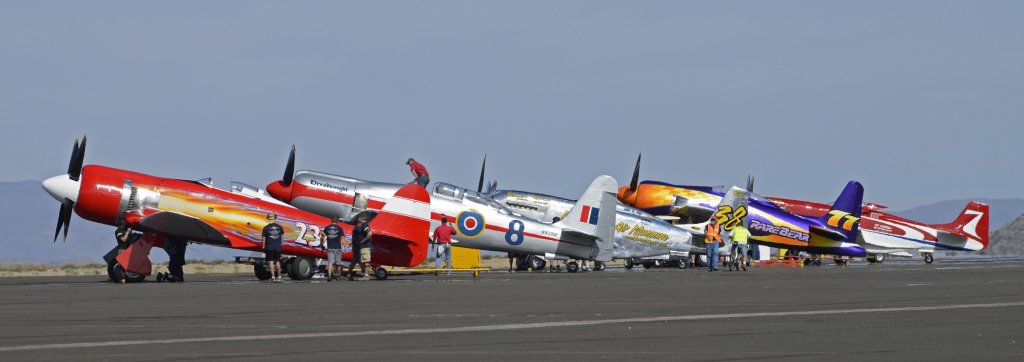 |
| Unlimited Racers on Ramp in Preparation for Friday’s Gold Heat |
Race Week
In 2011 there were 30 aircraft entered in the Unlimited Division, although there were only 27 positions available on the racing roster. This year only 19 aircraft were in the field, with the reasons for the reduction many and varied. For one, as a way to make funds available for the insurance premium, the amount of money in the purses was reduced. Several of last year’s participants opted out on this count alone. Several other racers decided to either suspend or stop racing altogether. This included the long-time favorite Voodoo, and Gerry Gabe’s P-51A Polar Bear, that has been sold to a new owner. Unfortunately, in addition to The Galloping Ghost, two other racers were lost during the year, Howard Pardue and his XF8F-1 Bearcat, along with Bob Odegaard and the #74 Super Corsair. On the up-side, two interesting racers returned following long absences: They were Chuck Greenhill’s highly modified and totally rebuilt Sea Fury #15 Furias, and the Sanders Brothers #924, a Sea Furypowered by the originalCentaurussleeve valve engine.
The Racing Airplanes
The Unlimited Division spans three racing classes; Bronze, Silver and Gold. The class of any particular airplane is determined by qualifying speed, with up to nine airplanes assigned to each race depending upon the day and number of aircraft available. As an incentive to qualify fast, the top six airplanes do not race until Friday, giving them an extra day of preparation while minimizing wear and tear on engines and crew. The following is a description of each of this year’s Unlimited racers, presented in the order in which they qualified. To note, when comparing qualifying and racing times to previous years it is important to remember that the Unlimited course was shortened this year to 8.1034 miles from the previous 8.4333 miles. The breakdown as to aircraft types entered this year: seven P-51 Mustangs, six Sea Furys, two Yaks, one F4U Corsair, one F8F Bearcat, one F7F Tigercat and one FM-2 Wildcat.
 |
| Unlimited racer Strega, piloted by Steven Hinton was out front by himself all week! |
#7 – Strega, a modified P-51D Mustang with a Mike Nixon Merlin, flown by Steven Hinton, qualified at 493.299 mph. This was not as fast as his last year's record setting 499.160 mph; the difference is likely due to the new course length and shape. This airplane has been a serious competitor and winner at Reno for many years. At the current time it is at the top of its game and can certainly best the competition as none of the others seem to be able to keep up. The big issue with the Merlin powered racers has always been keeping them together for the duration of the week. Mike Nixon and his engine team from Vintage V-12’s have got it figured out. Their engine has all of the basic Dwight Thorne mods for the racing Merlin; Allison connecting rods, extra structural bracing, improved lubrication system, along with steel main bearing caps and a special cam grind, as well as a number of other tweaks that allow all of the parts to be happy for the week. Interestingly, the pilot is also one of the major “wrenches” on the engine. Mike says that if a water-boiler oil cooler was installed that the airplane would be capable of 550 mph on the course, up from its current potential of 515 mph.
Hinton qualified the airplane at 493.299 mph, down slightly from his 499+ mph speed of last year. This change marks a trend seen with a number of other qualifiers, that this year’s speeds are less than before, which can be attributed to the revised and slightly shorter course. Steve reports that he likes the new shorter course, it’s smoother and faster and he has no need to retrim Strega during each lap. During the Gold heat races “Steveo” showed a consistent strategy of “coming down the chute” onto the course at very high power and taking the lead from his pole position. He would then back off the power a bit and settle into a very smooth and fast path around the pylons. On Friday his speed for the heat was 473.257 mph, on Saturday 472.642 mph and on Sunday 477.523 mph. His closest competition at the end of all three races was “Hoot” Gibson in the #232 Sea Fury, even so Strega held a 20 mph advantage, a margin of about 20 seconds, between the two. The hoped for, and expected, challenge by Rare Bear never really happened, as the effort to catch Strega caused concern due to high cylinder head temperatures for Rare Bear, which in turn lead to backing off from attempting to catch Hinton. In the hands of this team Strega has shown that the Merlin powered Mustang can be a very reliable, and fast, competitor.
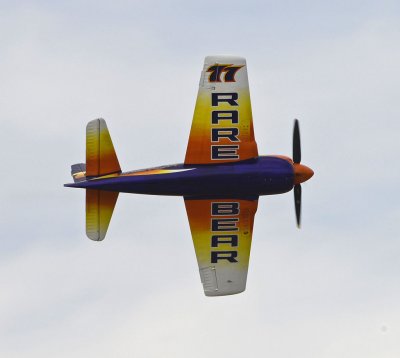 |
| Rare Bear looked and sounded good all week, but the cylinder head temperature Gremlins kept the team from challenging Strega for the lead. |
#77 – Rare Bear, a modified F8F-2 Bearcat powered by a Dave Cornell built Wright R-3350 and flown by Stu Dawson. This is another very popular and historic Reno racer, with a long history of winning, although not in the recent past. Problems with instability in the carburetor intake trunks that were an issue last year were resolved by installing a newly designed and accurately fabricated pair of mirror image trunks. Things looked good as Stu qualified the airplane at 490.002 mph; however he was initially disqualified for having exceeded the newly enforced 250 foot maximum height above the ground rule. This ruling was subsequently overturned and the time reinstated. Unfortunately “The Bear” was not able to maintain this speed during the week’s heat races as cylinder head temperatures were exceeding 500 °F, and the power would then be reduced. Lots of work in the pits was done to resolve the problem, this included new spark plugs, recalibration and replacement of the temperature indicators, and resetting the carburetor and water injection system. In both the Friday and Saturday races Stu finished third, having reduced power because of the apparently high cylinder head temperatures. Race speeds were approximately the same each day at about 436 mph. For the Sunday Gold heat the team recalibrated the temperature indicators and again reset both the carburetor fuel flow and increased ADI by about 1/3, all intended to get the engine to run cooler. They were prepared to, and did for a while, run the big Wright at 75 inHgA and 3,200 rpm (4,000 bhp). With this power Rare Bear was able to stay up with Strega, but the temperatures again began to climb and Stu backed off the power for the last half of the race, and finally Maydayed out on the last lap, resulting in a DNF.
 |
| The beautifully prepared R-4360 powered Furias, with its new “water boiler” oil cooler, was all set to give the guys up front a challenge. Then there was a problem with the right landing gear, which collapsed on landing following his qualifying run. Matt Jackson, the pilot, was OK, but the airplane will have to wait for next year. |
#15 – Furias, a modified Sea Fury FB.11 powered by a Pratt & Whitney R-4360, flown by Matt Jackson. After sitting out several years while it was completely rebuilt and upgraded, Furias was back and looking good! One of the upgrades was installation of a water-boiler cooling system for the oil cooler, significantly reducing drag and giving the airplane a big boost in speed. After takeoff for his qualifying run the landing gear would not fully retract, so Matt cycled the gear and it locked up OK. His qualifying speed of 467.287 mph was done with only takeoff power, in deference to the new airplane and engine. Then things turned sour. When the right gear was extended for landing it would not lock down. The safety check plane said it looked good so Matt brought it in, he bounced it to check the gear, it seemed OK, but when he set it down the gear collapsed and did a lot of damage to the airframe and beautiful paint job. Matt was OK, but Furias was out.
 |
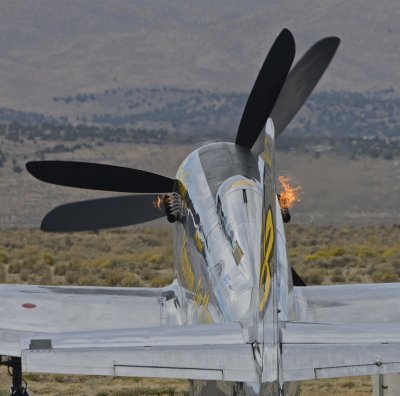 |
| Precious Metal is finally beginning to perform as well as it looks. In its new configuration it has gone faster than any previous Griffon powered racer. | This view of Precious Metal gives a good perspective on the newly shaped propeller blades, a planform similar to that used on the Lockheed C-130J. With this and improvements to the induction trunk the airplane qualified 64 mph faster than last year. |
#38 – Precious Metal, the P-51XR, a highly modified P-51D powered by a Rolls-Royce Griffon 57A with contra-rotating propeller; flown by Thom Richard. Richard has only had the airplane for a couple of years and this year he showed up with a lot of important changes, most of which (except for the new paint scheme) do not show.
Of importance is the new carbon fiber duct feeding the Bendix PR-100 carburetor (original to the R-4360) fitted to the big Griffon. The increased ram recovery from the duct results in an additional 21 inHg manifold pressure when coming “down the chute”. The other major change is a set of entirely reshaped and longer propeller blades, compared to those previously on the airplane. Thom designed a new blade profile that is similar to those on the C-130J, which operate in the same power loading and Mach range. The airplane is quite happy with the new propeller, it gives a shorter takeoff run, better climb rate and cruise speeds are increased 15-20 mph. All of the changes resulted in qualifying at 600-800 rpm slower, but posting 463.301 mph compared to 399.178 mph last year. Thom raced well on Friday and Saturday, finishing in 4th, some 10 and 14 seconds behind Rare Bear both days, but on Sunday, when coming down the “chute” for the start at a speed of 514 mph, an up-lock spring on the right clamshell landing gear door broke and the gear door departed the airplane. Notified of the loss by one of the other racers on the third lap of the race he did the smart thing, Maydayed, and returned to the field for a safe landing.
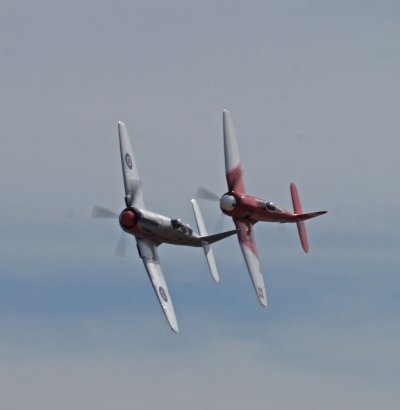 |
| Dreadnought and #232 were hard at it in Thurday’s Silver heat. Both racers advanced to the Gold class for the rest of the week. |
#8 – Dreadnought, a modified Sea Fury T.Mk.20 powered by a Pratt & Whitney R-4360, flown by Dennis Sanders. On Thursday, the first day of Unlimited racing, Dreadnought won the Silver heat at a speed of 443.764 mph, just edging out Hoot Gibson in the #232 Sea Fury who was not using full power as he was still “breaking in” his newly rebuilt R-3350. Even so, #232 was pushing hard enough that both aircraft exceeded their qualifying speeds. With the win, Dreadnought then moved into the Gold Heats for the rest of the week. In Friday’s Gold Dennis was edged out by Precious Metal in a close battle for fourth place, but both aircraft speeds were well below their qualifying speeds. Certainly they were saving something for the rest of the week. On Saturday Dreadnought again finished close behind Precious Metal (4 seconds) and had given the fans a good race. Sunday Dennis’s strategy of slow and steady with the big racer paid off when two of the airplanes ahead of him, Rare Bear and Precious Metal pulled off the course before the finish and he brought Dreadnought in for a 3rd place finish.
 |
| Sawbones is a stock Sea Fury, but powered by a Wright R-3350-26WA from a Skyraider. Raced in the Silver class all week, but advanced to Sunday’s Gold by winning the Saturday Silver. |
#71 – Sawbones, a Sea Fury FB.11 powered by a Wright R-3350-26WA, owned by Orthopedist Robin Crandall and flown by Curt Brown. A good solid “Silver” class racer, Curt finished 3rd in the Silver on Thursday, 2nd on Friday, and won the Saturday Silver heat at a speed of 402.338 mph, allowing him to race in Sunday’s Gold final. After the Saturday heat the team realized that there were problems with the spray bars for the oil cooler, so they had a long and busy night getting things ready for the Sunday Gold heat. There he finished fourth with a speed of 393.001 mph. None of Sawbones’s speeds during the week matched his qualifying speed of 424.175 mph. They were all in the range of 392 to 402 mph, suggesting that the airplane was racing using takeoff power, which for a stock R-3350-26WA at takeoff is 56.5 inHgA at 2,900 rpm, developing 2,700 bhp.
#11 – Miss America, a modified P-51D powered by a Rick Shanholtzer V-1650 race Merlin, and flown by Brent Hisey. Hisey qualified the airplane on Tuesday, but was subsequently disqualified for having flown too high. He then went out during the last qualifying period on Wednesday and posted a time of 414.061 mph, placing him in the Silver class. In Thursday’s Silver he finished fifth, but on Friday won the heat with a speed of 402.854 mph, after reportedly backing the power off by 30 inches once he got ahead of #232 and into the clean air out front. This win advanced Miss America into the Gold class for the last two days of racing. Hisey’s speeds posted for those days are for one less lap than the rest of the field, as he was more than half a lap behind Strega at the finish.
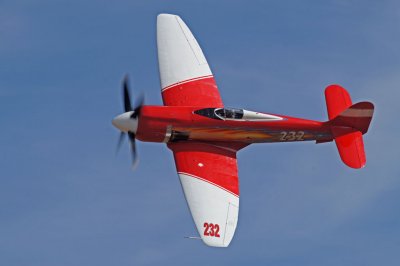 |
| Shuttle astronaut “Hoot” Gibson scored three wins in #232 over stablemate Rare Bear in this year’s Gold class. The racer just kept getting better every day, while “The Bear” was in the clutches of Gremlins. Hoot said that “two more heats and he would be an ‘Ace’ with five wins over Rare Bear”. |
#232 – This modified Sea Fury FB.11 is powered by a special Wright R-3350, and flown by former shuttle astronaut “Hoot” Gibson. This airplane, a previous Gold class winner as September Fury, suffered a burnt piston last year, which resulted in a complete engine teardown and cleaning as well as fitting a new cylinder. The airplane has a “water boiler” oil cooler and is very fast. In Thursday’s Silver heat Hoot finished second, only about half a second behind Dreadnought. This was a really exciting race; both airplanes besting their earlier qualifying times and advanced to the Gold class for the rest of the week. On Friday the three “ceded” Gold racers were on the course for the first time, joined by 232 and Dreadnought, and putting up a good race. The interesting “race” was between owner Rod Lewis’s Rare Bear and 232. They were parked in adjacent pits and there is a lot of friendly competition between the crews and pilots. Because of “The Bear’s” cylinder head temperatures issues, Rare Bear was not using full power. #232 was not either, however in taking second place the R-3350 was running at about 60 inHgA and 3,000 rpm (approx 3,225 bhp). As for #232 and Rare Bear, Saturday’s Gold Heat was a repeat, with both airplanes following Strega in a 1-2-3 finish. Interestingly, all three of these racers finished with speeds within about ½ mph of their Friday speeds. Sunday’s Gold heat was looking to be another 1-2-3 finish for these racers, that is until the temperature Gremlin again caught up with Rare Bear and Stu elected to Mayday out on the last lap. Hoot had been running his engine at 65 inHgA and 3,000 rpm in an effort to stay with “The Bear” and as a result finished in second with his best speed of the week, 456.746 mph.
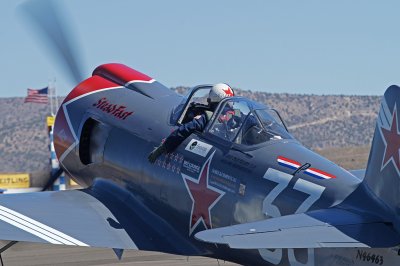 |
| Will Whiteside in his Yak-3U Steadfast, powered by a hardworking P&W R-2000. Will won the Sunday Silver heat at 394.5 mph, the same speed at which he qualified. |
#33 – Steadfast, a highly modified Yak-3U powered by a Pratt & Whitney R-2000, owned and piloted by Will Whiteside. In 2011 Whiteside flew Steadfast to a new 3-kilometer world record speed of 416 mph, breaking the old record of 304 mph for this weight class. He followed this up with four new time to climb records in 2012, reaching 3,000 meters (9,842 feet) in two minutes, five seconds. The previous record for this weight class was three minutes and 33 seconds. Will has been working for a number of years to make Steadfast a really competitive Silver racer, and he is getting results. The R-2000 was originally rated by the military to deliver 1,450 bhp at 2,700 rpm and 48.7 inHgA manifold pressure in low blower. By speeding the engine up during the race Will is able to develop more manifold pressure and power, typically running in the range of 2,800 rpm and 53 inches, which adds about 250 hp when running “wet”. Even so, Will has incorporated an ADI (water injection) system for the engine, which increases the density of the mixture and further increases power. When needed he can push the rpm up even further for power to pass.
In the Thursday Silver heat race Steadfast finished 4th, on Friday 3rd, just ahead of the big Sea Fury Argonaut, and on Saturday Will finished 2nd again in front of Argonaut. Keeping with the 4-3-2 trend, in Sundays Silver final Steadfast won, at a speed of 394.520 mph, a hair faster than his qualifying time of 394.507 mph, and besting Argonaut who was close on his heels. This made for some exciting racing!
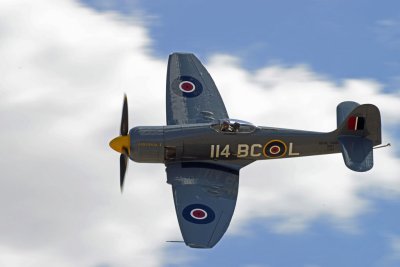 |
| Argonaut is the first P&W R-2800 powered Sea Fury. If there is any difference in the capability of the airplane with the R-3350 and R-2800 it is slight, and more than made up for by the improved durability and availability of parts. |
#114 – Argonaut, a Sea Fury FB.11 powered by a Pratt & Whitney R-2800, flown by Korey Wells. This was the second season for Argonaut with the R-2800-CB3. The R-2800 took the place of the previous R-3350-26WD radial engine, which had proved troublesome and with difficult to find critical parts. It appears that the R-2800 in the stock Sea Fury is a good fit, and nearly as fast as the R-3350 version. With the R-3350 Argonaut would qualify in the 408-413 mph range, and with the R-2800 the qualifying speeds have been 402 and 394 mph. Different pilots and different conditions can account for these differences, so clearly Argonaut is a competitor. This was shown in Thursday’s Bronze heat when Argonaut edged out the Centaurus powered Sea Fury #924 for the win. This win advanced Wells into Friday’s Silver heat, where he followed Steadfast and finished 4th. This pattern continued through the rest of the week, finishing just behind Steadfast for a 3rd on Saturday and 2nd on Sunday. Typical power settings when racing are 61 inHgA and 2800 rpm. An ADI system is fitted to the carburetor and spray bars keep the oil cool. Good racing for the big radial.
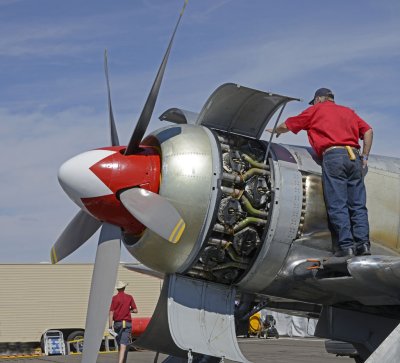 |
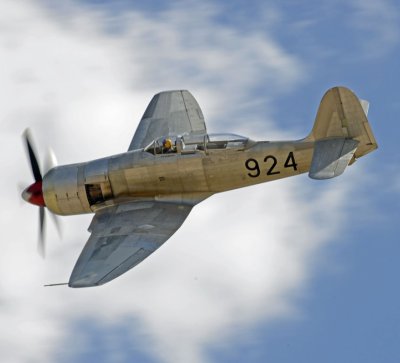 |
| It was great to see Sea Fury #924 with it’s the mighty 18-cylinder Centaurus and 5-bladed Rotol back racing! | |
#924 – 924, a Sea Fury T.Mk.20 powered by its original Bristol Centaurus engine, flown by Brian Sanders. This airplane just returned to flying after a 15 year hiatus during which it was completely rebuilt. It is a unique racer in the current era in that it is powered by its original sleeve-valve 18 cylinder Centaurus engine. Brian qualified the airplane at 380.789 mph, which placed him in the Bronze class for Thursday’s race. There he placed 2nd, just behind Argonaut, which elevated both aircraft into the Silver for Friday. For the Thursday, Friday and Saturday heats he ran the same power setting which resulted in speeds of 356, 354 and 355. Then on Sunday he stepped it up a bit and ran 363.737 mph, the result being that each day in the Silver he had progressed one finishing spot: Friday 5th, Saturday 4th, and on Sunday 3rd where he was being chased closely by the big F7F Tigercat Here Kitty Kitty.
#44 – Sparky, a stock Merlin powered P-51D flown by Brant Seghetti. This airplane in its “Jelly Belly” paint scheme has to be one of the most photographed airplanes on the circuit. It is very colorful and when someone wants an in-air publicity shot for the Races, Sparky is often it. Sparky is a 15th Air Force combat veteran and has been raced at Reno since 1994. Brant qualified at 353.822 mph, which placed him in the Bronze class for the week. His Thursday and Friday heats were fairly leisurely at 309 and 306 mph, finishing 4th and 3rd respectively, but he then stepped it up on Saturday and Sunday to 323 and 330.253 mph, and was hot on the heels of P-51 Lady Jo on both days, finishing 3rd and 2nd respectively. Fun racing for position.
 |
| Here’s The Rebel, a P-51D representative of the other stock P-51s in this year’s field. Doug Matthews won the Friday Bronze in #12, and then advanced to the Silver class for the rest of the week. Note the radiator spray bar is hard at work keeping the big Merlin cool, suggesting that he is pulling a bit more than takeoff power! |
#12 – The Rebel, a stock Merlin powered P-51D flown by Doug Matthews. Doug finished 3rd in Thursday’s Bronze heat, well behind two Sea Fury’s. On Friday, and with the Sea Fury’s advanced to the Silver heat, he won a very close Bronze heat with a speed of 342.936 mph; a margin of only 0.100 seconds over the big Tigercat Here Kitty Kitty. This win advanced The Rebel to the Silver class for the rest of the week. There he finished 5th both days. On Sunday, even though he finished last in the Silver heat his speed of 345.418 mph was faster than that with which he won the Friday Bronze.
#81 – Lady Jo, a stock Merlin powered TF-51D Mustang raced by Dan Vance. Dan raced in the Bronze heats all week. On Thursday and Friday finishing last, but once the more competitive airplanes had advanced into the Silver class, he stepped it up, coming in 2nd on Saturday and winning the final on Sunday at a speed of 330.507 mph.
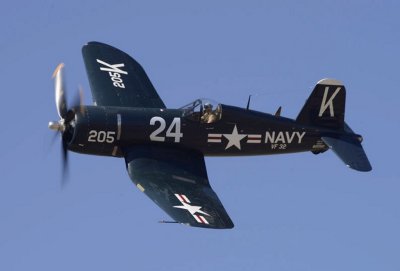 |
| Seeing and hearing the #24 Corsair and its mighty R-2800 on the pylons is an unforgettable experience. Seeing the stock WWII era fighters compete in the Bronze heats gives a good idea as to the relative capabilities of the various aircraft types. |
#24 – Corsair, a stock Pratt & Whitney R-2800 powered F4U-4 Corsair flown by John Currenti. This airplane added a lot of character to the racing as it was the only one of its type and is really a lot of fun to see on the course. John qualified the airplane at 327.058 mph and ran the airplane at speeds ranging from 312 to 317 mph during his four heats. On Thursday he raced in the “Medallion” heat and finished a distant 2nd to the winner Here Kitty Kitty. Racing in the Bronze class for the rest of the week he finished 4th, except on Sunday when he had his best time and finished 3rd.
#31 – Speedball Alice, a stock Merlin powered P-51D flown by Rob Gordon. A good dependable Mustang used as the safety plane for the non Gold heats when not in the heat as a racer. Dan Vance qualified Speedball Alice at 326.739 mph. Rob then took over for the heat races and ran her in the Medallion and Bronze heats at speeds ranging from 290 to 302 mph.
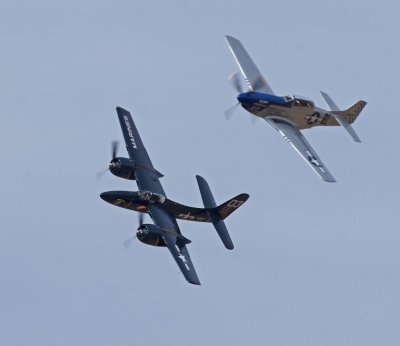 |
| Here Rod Lewis in the Tigercat is passing the P-51DLady Jo on his way to nearly catching the winner of this Friday Bronze heat. Lady Jo finished with a speed of 305 mph and Here Kitty Kittyat 342 mph. |
#55 – Here Kitty Kitty, a stock Grumman F7F-3P Tigercat powered by two Pratt & Whitney R-2800 Double Wasp engines, piloted by both owner Rod Lewis and Stu Dawson. On his qualifying run Rod had some cooling concerns and held the speed down to 317.090 mph, the result being that he had to run in Thursday’s Medallion heat. This he won handily, at a speed of 354.600 mph, advancing him into the Friday Bronze class. There he was only 0.100 seconds behind the Mustang The Rebel, finishing 2nd. On Saturday he bested the Bronze field and won with a speed of 342.868 mph, thereby advancing into the Sunday Silver final. For that race Rare Bear’s regular pilot Stu Dawson took the controls and raced Here Kitty Kitty to a respectable 4th place finish. Not bad for the week: racing from 17th to 9th position overall.
#0 – Rossiya Su’Ka, a Yak-3UPW powered by a Pratt & Whitney R-1830 and flown by owner pilot Jim McKinstry. Jim qualified at 307.157 mph, a little better than last year’s 306.855 mph, and started in Thursday’s Medallion. While on the second lap of the race his landing gear up-lock disengaged and the gear were in a partially extended position. Jim pulled out of the race and circled while working to get the gear fully extended and locked down. This he did and made a safe landing. Unfortunately he was not able to get the system repaired, so had to sit out the rest of the week’s racing.
#2 – Air Biscuit, a stock FM-2 Wildcat powered by a Wright R-1820-56 and piloted by Brian Sanders and Korey Wells. Air Biscuit is a lot of fun to watch on the course because it flies a slow and tight course. At times they have had trouble meeting the required minimum 300 mph qualifying speed, but this year they were fine at 304.776 mph. In Thursday’s Medallion Brian clocked 277.787 mph and finished last. Friday’s field for the Bronze was filled with faster airplanes, so Air Biscuit stood down, rejoining the Bronze class on Saturday and Sunday, where Korey posted speeds of 288.511 and 268.394 mph respectively, while finishing last.
Summary
After last year’s tragedy and the overall uncertainty surrounding the 2012 races, when the racers were all safely back on the ground at the conclusion of Sunday’s Unlimited Gold there was a huge celebration of the accomplishment by all involved and admiration for those who worked so hard to make the 2012 races as success. The racers were likewise appreciative of the fans and RARA for supporting the races and continuing this pageant that is so unique and exciting. 2013 will be the 50th year for the National Championship Air Races – Reno. It promises to be every bit the excellent show that was enjoyed by so many this past year, and even more grand in its presentation. To this end, the 50th Reno Air Races will be a particularly unique event. If you have the opportunity, be there!
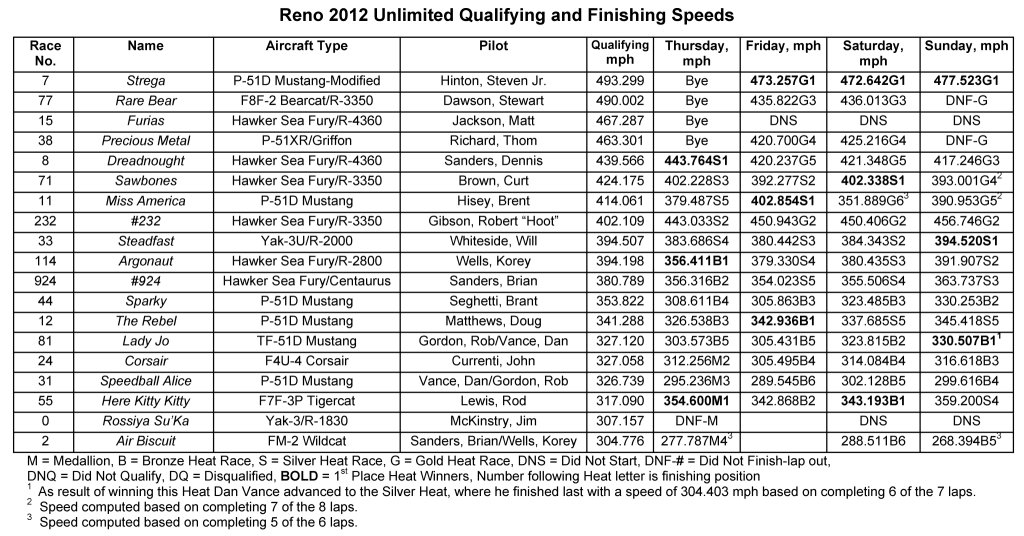 |